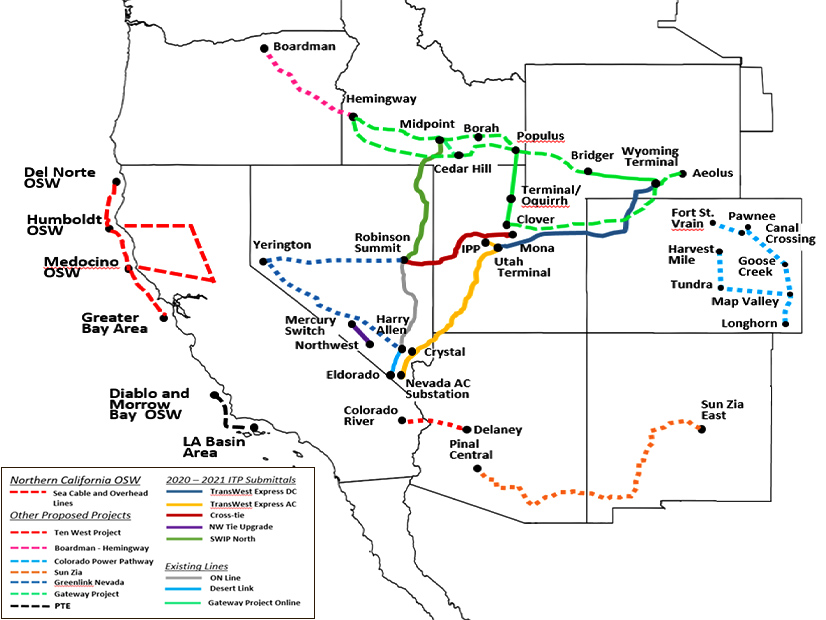
The backers of two separate initiatives to spur development of new transmission in the West are taking different approaches on when to deal with the issue of who should pay for projects.
The backers of two separate initiatives to spur development of new transmission in the West are taking different approaches on when to deal with the issue of who should pay for projects.
The Western Transmission Expansion Coalition (WTEC), launched by the Western Power Pool (WPP) and backed largely by the power sector, wants discussions about cost allocation to be put on the back burner while industry stakeholders first figure out what should be built.
But the Western States Transmission Initiative (WSTI), established by state regulators, thinks cost allocation must be addressed before serious planning can begin. (See In West, Proposals for Tx Planning Proliferate Faster than New Lines.)
WPP CEO Sarah Edmonds said WTEC efforts “aren’t touching cost allocation”; the subject is outside the intended scope of the effort, which is designed to expand the geographical scope of transmission planning to include all the West. “We aren’t part of a cost allocation federal tariff,” she noted during a Dec. 11 meeting of the CAISO Western Energy Imbalance Market’s Regional Issues Forum (RIF).
“Cost allocation is kind of one of those things that has really chilled conversation in the West around transmission planning. If we took that off the table for the WTEC effort, what might we find in terms of creative ideas?” Edmonds said.
While acknowledging the conundrum around the matter, Matthew Tisdale — executive director of decarbonization nonprofit Gridworks, which is partnering with the Committee on Regional Electric Power Cooperation on the WSTI — sees a problem with that approach.
“I think that planning and cost allocation are sort of a chicken and an egg here,” Tisdale said at the RIF meeting. “It’s hard to do the planning without understanding what is going to be the approach to cost allocation, and it’s difficult to do the cost allocation without knowing what you’re planning for.”
Both initiatives have set the stage for conversations about who will incur the costs and reap the benefits of much needed transmission projects in the West.
A key goal of WSTI is to form a Transmission Working Group that would, among several tasks, advance the discussion on transmission cost allocation. The states, Tisdale said, will be leading the conversation and coordination around how the cost of interregional transmission could be allocated across state lines.
‘Taking the Bull by the Horns’
While Tisdale, Edmonds and CAISO officials at the meeting agreed that states should be the entities to determine cost allocation for transmission projects, some stakeholders expressed concern about the challenges of that approach for allocating costs across state lines.
Matt Lecar, principal at Pacific Gas and Electric, highlighted complexities surrounding different regulatory requirements; for example, California could agree on a cost allocation framework not matched by entities elsewhere in the region.
“I get that having the states buy in on a cost allocation framework brings down the risk barrier, but what’s going to convince me that the billion dollars or more that I spend on constructing and bringing online a project is going to lead to a successful cost recovery via a mix of jurisdictions that may or may not see eye-to-eye on whether those costs were prudently incurred?” Lecar said.
“Discussions around ratepayer recovery of transmission facilities have been challenging under [FERC] Order 1000, and we need to have the cost allocation conversation,” said Danielle Osborn Mills, director of market policy development at CAISO. “In the meantime, we’re trying to think creatively around how we can have bilateral arrangements that lead to shared benefits across the region and also appropriately shared costs.”
Michele Beck, director of the Utah Office of Consumer Services, emphasized the need for greater coordination among consumer advocates, regulators and transmission planners. She expressed concern that while the WSTI interviewed more than 40 stakeholders, consumer advocates were not included.
Beck also noted that while the WSTI has signaled it will include public interest organizations in a Western transmission conference it intends to host, consumer advocates were again left out.
“We’re very cautious about an emphasis on cost allocation and moving forward on that, especially when we may or may not be at the table,” Beck said. “In our view, sometimes that can be a euphemism for finding a way to get more people to pay for projects … that might be desired only by a subset of the folks involved.”
While there was some disagreement on how costs should be allocated, energy officials seemed to agree upon the struggle to find a better option.
“The states leading on cost allocation is probably the worst forum for developing cost allocation — except for all the other ones, because all the other ones haven’t worked for 20 years either, and so we want to see some leadership in the region,” Tisdale said. “We want to see somebody taking the bull by the horns and raising hard questions.”
A public webinar regarding the WTEC project is scheduled for Jan. 29.

